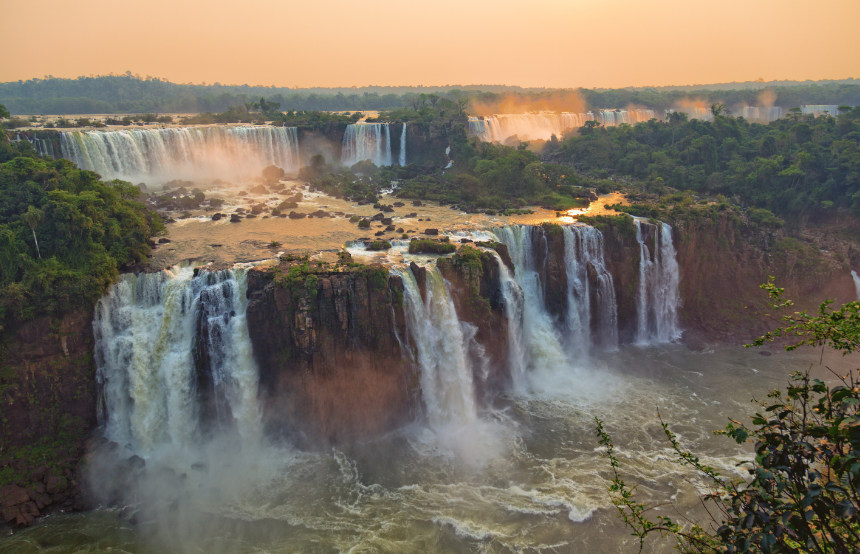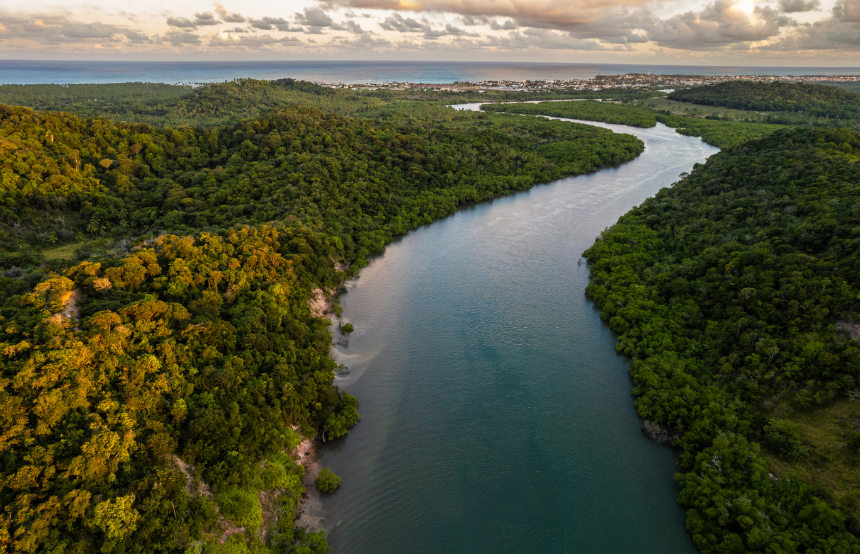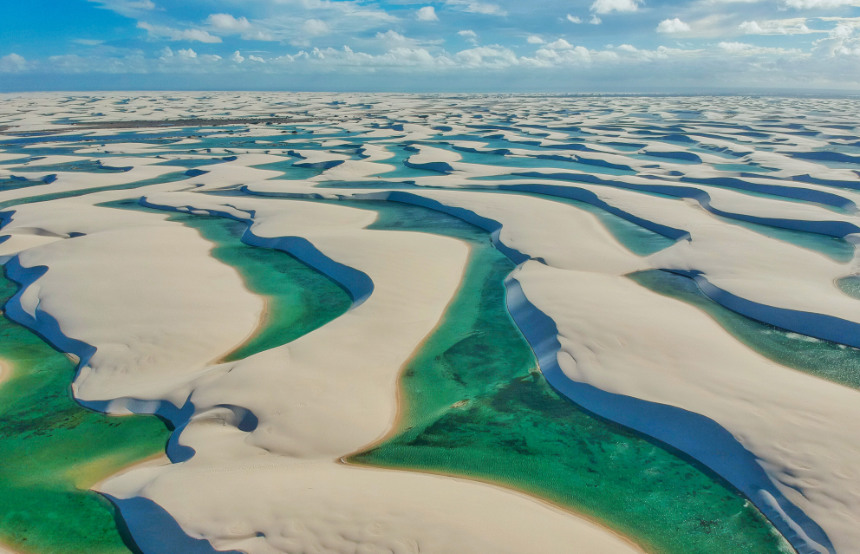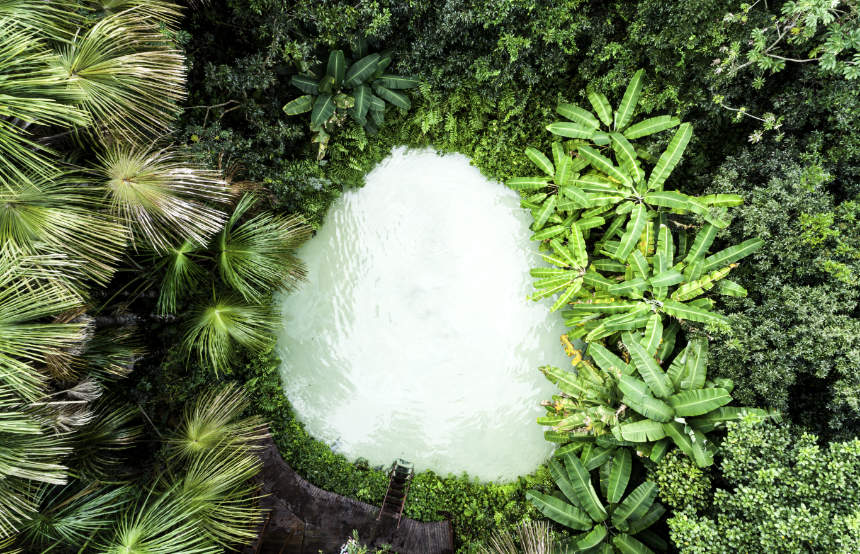When it comes to wildlife, Brazil tops the list of ‘mega-diverse’ countries, boasting between 15 and 20 percent of the world's total biodiversity. This title could equally extend to the breath-taking variety of environments which weave together to form the fabric of this extraordinary nation. As the largest country in Latin America, Brazil’s landscapes are legendary in scope; among them you’ll find the world’s largest waterfall system (Iguaçu Falls), one of the New Seven Wonders of the World (Christ the Redeemer) and part of the planet’s largest tropical rainforest (the Brazilian Amazon). If these notable accolades aren’t enough to tempt you, our list of unmissable landscapes in Brazil also contains some lesser-known gems, well-worth diving into the treasure trove of attractions for.
- Iguaçu Falls
- Fernando de Noronha
- Sugarloaf & Corcovado Mountains
- Dunas de Genipabu
- Amazon Rainforest
- Pantanal
- Lençóis Maranhenses National Park
- Jalapão State Park
- Inhotim
- Bonito
1
Iguaçu Falls
As the world’s largest waterfall system, Iguaçu Falls eclipses both Victoria and Niagara Falls in terms of stature and scale. Spanning the border between Brazil, Argentina, and Paraguay, Iguaçu translates to ‘Big Water’, although even this nod to its vast size can’t adequately convey the sheer power and magnificence of the falls. If you’re feeling daring, head to Devil’s Throat – the tallest of Iguaçu’s 275 waterfalls – to gaze into the thundering cascades from the edge of a wooden platform.

2
Fernando de Noronha
Part UNESCO World Heritage site, part National Marine Park (and undisputed slice of paradise), this archipelago of 21 volcanic islands is remote and rugged, yet definitely worth making the trek for. Only one of the rocky islets is inhabited (with a population of 5,000 people), while the rest play host to endemic species and untouched beaches. And with only a handful of pousadas (Portuguese inns) scattered across Fernando de Noronha, it’s likely you’ll have one of its Eden-esque scoops of sand all to yourself.

3
Sugarloaf & Corcovado Mountains
The peaks of Sugarloaf and Corcovado cast watchful eyes over Rio de Janeiro, Brazil’s second city, forming one of the most recognisable landscapes in Brazil. Sugarloaf is so-called for its resemblance to a refined loaf of sugar, while Corcovado is Portuguese for ‘hunchback’. Both are worth visiting, as the latter is the location of the iconic Christ the Redeemer statue (one of the New Seven Wonders of the World), and the former features a cable car, offering sweeping vistas of the snap-ready scenery.

4
Dunas de Genipabu
The only thing better than a pristine expanse of buttery sand is a whole complex of idyllic dunes, and that’s what you’ll find at Dunas de Genipabu, near Natal in the state of Rio Grande do Norte. Gently lapped at by an azure freshwater lagoon and constantly reshaped by coastal winds, you’ll never see the exact same landscape twice, with the ever-changing dunes drawing in repeat visitors. Roam the dunes by various means, including on camelback, by buggy or via sandboard.

5
Amazon Rainforest
A list of unmissable Brazilian landscapes wouldn’t be complete without the Amazon rainforest, one of the planet’s most ecologically complex areas. Straddling an impressive nine countries and playing host to one in ten known species on Earth, it would be difficult to overstate the significance and splendour of the tropical expanse. Explore the waterways aboard a canoe, and stay in a stylish eco-lodge, located deep within its emerald heart.

6
Pantanal
Another hub of biodiversity, the Pantanal rivals the Amazon when it comes to wildlife, especially in terms of sightings (thanks to the openness of the wetland). Occupying 80,000 square miles in the centre of South America – an area the size of Kansas – 80% of the inland delta is found in Brazil, with the remainder spilling over into Bolivia and Paraguay. Keep your eyes peeled for crocodiles, jaguars and giant river otters, and tick off as many of the 650 bird species as you can.

7
Lençóis Maranhenses National Park
Lençóis Maranhenses means the ‘bedsheets of Maranhenses’ in Portuguese, an apposite name for the sea of undulating sand dunes draped across Brazil’s north Atlantic coast. The valleys in between each dune fill with pools of water during the rainy season and the far-flung position of this Brazilian landscape means it remains delightfully uncrowded. Visit between July and September to witness the cradles of cobalt contrasted against the milky-white of the sand.

8
Jalapão State Park
If you wish to combine more than one type of terrain, Jalapão State Park promises a patchwork of cerrado (tropical savanna) vegetation, ochre-hued sand dunes and fervedouros (limestone karst springs). Its remote location, in the less-frequented state of Tocantins, has allowed the park to flourish in relative isolation. Float in the champagne-like waters of the turquoise fervedouros, bathe in the warm pool at the base of the Cachoeira da Formiga waterfall and see the dunes painted deep-orange and pink by the sinking sun.

9
Inhotim
Inhotim is intriguing for a number of reasons. On first glance, you’ll be struck by the lush greenery and prosperous plants of the botanical gardens. Yet, upon closer inspection, you’ll notice an array of art installations tastefully positioned among the foliage. Founded by former mining mogul, Bernardo Paz, and situated near the city of Belo Horizonte in Minas Gerais, the open-air art gallery showcases one of the country’s largest contemporary art collections. The result is a pleasing blend between the natural landscape and the striking man-made sculptures.

10
Bonito
While there are myriad more unmissable landscapes in Brazil, we have to conclude this list somewhere, and the country’s ecotourism headquarters in Matto Grosso do Sul is an excellent place to do so. Bonito (meaning ‘beautiful’) is certainly worthy of its name, boasting shimmering lakes, cascading waterfalls, stalactite-clad caverns and its fair share of comfortable eco-lodges. The main draw of the rural region is the chance to snorkel and dive among the shoals of tropical fish which populate the freshwater pools.
Written by Luisa Watts














